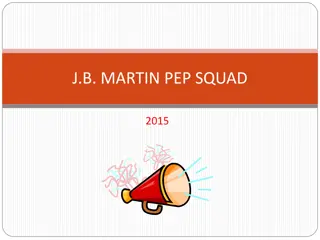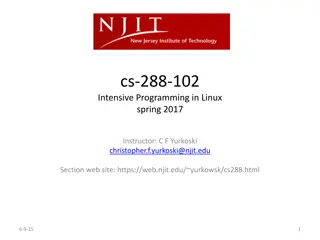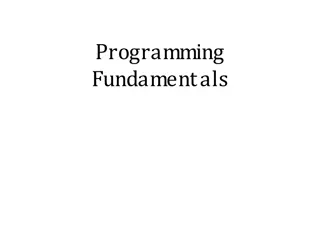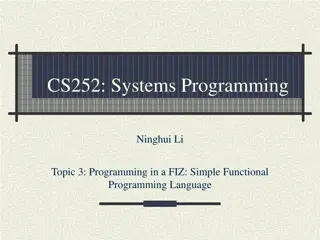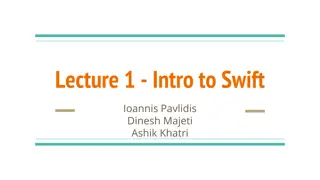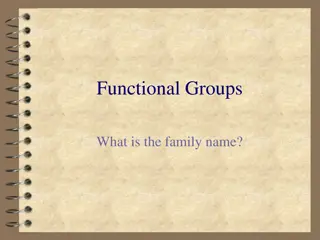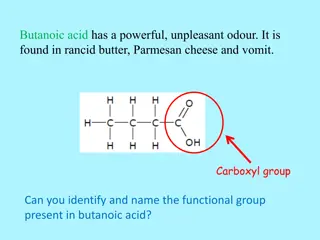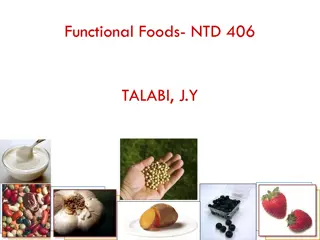Tackling the Awkward Squad in Functional Programming
Functional programming is known for its beauty in concise abstractions and high-order functions, but it often struggles with managing the "Awkward Squad" of input/output, imperative state, and error handling. The Direct Approach involves dealing with side effects and imperatives directly but can lead to issues. In lazy functional languages like Haskell, the order of evaluation is undefined, challenging traditional approaches. However, the IO monad in Haskell offers a solution by combining laziness and side effects in a structured way, providing means to handle IO, imperative operations, exceptions, foreign functions, and concurrency.
Uploaded on Oct 09, 2024 | 0 Views
Download Presentation

Please find below an Image/Link to download the presentation.
The content on the website is provided AS IS for your information and personal use only. It may not be sold, licensed, or shared on other websites without obtaining consent from the author. Download presentation by click this link. If you encounter any issues during the download, it is possible that the publisher has removed the file from their server.
E N D
Presentation Transcript
Comp150PLD THE IO MONAD Reading: Tackling the Awkward Squad, Sections 1-2 Real World Haskell, Chapter 7: I/O Thanks to Simon Peyton J ones for many of these slides.
Beauty... Functional programming is beautiful: Concise and powerful abstractions higher-order functions, algebraic data types, parametric polymorphism, principled overloading, ... Close correspondence with mathematics Semantics of a code function is the math function Equational reasoning: if x = y, then f x = f y Independence of order-of-evaluation (Church-Rosser) e1 * e2 The compiler can choose the best order in which to do evaluation, including skipping a term if it is not needed. e1 * e2 e1 * e2 result
...and the Beast But to be useful as well as beautiful, a language must manage the Awkward Squad : Input/Output Imperative update Error recovery (eg, timing out, catching divide by zero, etc.) Foreign-language interfaces Concurrency The whole point of a running a program is to affect the real world, an update in place.
The Direct Approach Do everything the usual way : I/O via functions with side effects: putchar x + putchar y Imperative operations via assignable reference cells: z = ref 0; z := !z + 1; f(z); w = !z (* What is the value of w? *) Error recovery via exceptions Foreign language procedures mapped to functions Concurrency via operating system threads Ok if evaluation order is baked into the language.
The Lazy Hair Shirt In a lazy functional language, like Haskell, the order of evaluation is deliberately undefined, so the direct approach will not work. Consider: Output depends upon the evaluation order of (+). res = putchar x + putchar y Consider: Output depends on how the consumer uses the list. If only used in length ls, nothing will be printed because lengthdoes not evaluate elements of list. ls = [putchar x , putchar y ]
Tackling the Awkward Squad Laziness and side effects are incompatible. Side effects are important! For a long time, this tension was embarrassing to the lazy functional programming community. In early 90 s, a surprising solution (the monad) emerged from an unlikely source (category theory). Haskell s IO monad provides a way of tackling the awkward squad: I/O, imperative state, exceptions, foreign functions, & concurrency.
Monadic Input and Output
The Problem A functional program defines a pure function, with no side effects. The whole point of running a program is to have some side effect. Tension
Before Monads Streams Program issues a stream of requests to OS, which responds with a stream of responses. Continuations User supplies continuations to I/O routines to specify how to process results. World-Passing The World is passed around and updated, like a normal data structure. Not a serious contender because designers didn t know how to guarantee single-threaded access to the world. Stream and Continuation models were discovered to be inter-definable. Haskell 1.0 Report adopted Stream model.
Monadic I/O: The Key Idea A value of type (IO t) is an action. When performed, it may do some input/output before delivering a result of type t.
A Helpful Picture A value of type (IO t) is an action. When performed, it may do some input/output before delivering a result of type t. type IO t = World -> (t, World) result :: t IO t
Actions are First Class A value of type (IO t) is an action. When performed, it may do some input/output before delivering a result of type t. type IO t = World -> (t, World) Actions are sometimes called computations. An action is a first-class value. Evaluating an action has no effect; performing the action has the effect.
Simple I/O () Char Char getChar putChar getChar :: IO Char putChar :: Char -> IO () Main program is an action of type IO () main :: IO () main = putChar x
Connection Actions To read a character and then write it back out, we need to connect two actions. () Char getChar putChar The bind combinator lets us make these connections.
The Bind Combinator (>>=) (>>=) :: IO a -> (a -> IO b) -> IO b () Char getChar putChar We have connected two actions to make a new, bigger action. echo :: IO () echo = getChar >>= putChar
The (>>=) Combinator Operator is called bind because it binds the result of the left-hand action in the action on the right. Performing compound action a >>= \x->b: performs action a, to yield value r applies function \x->b to r performs the resulting action b{x <- r} returns the resulting value v v r x a b
Printing a Character Twice echoDup :: IO () echoDup = getChar putChar c >>= (\() -> putChar c )) >>= (\c -> The parentheses are optional because lambda abstractions extend as far to the right as possible. The putChar function returns unit, so there is no interesting value to pass on.
The (>>) Combinator The then combinator (>>) does sequencing when there is no value to pass: (>>) :: IO a -> IO b -> IO b m >> n = m >>= (\_ -> n) echoDup :: IO () echoDup = getChar putChar c >> putChar c >>= \c -> echoTwice :: IO () echoTwice = echo >> echo
Getting Two Characters getTwoChars :: IO (Char,Char) getTwoChars = getChar getChar ???? >>= \c1 -> >>= \c2 -> We want to return (c1,c2). But, (c1,c2) :: (Char, Char) And we need to return something of type IO(Char, Char) We need to have some way to convert values of plain type into the I/O Monad.
The return Combinator The action (return v) does no IO and immediately returns v: return :: a -> IO a return getTwoChars :: IO (Char,Char) getTwoChars = getChar getChar return (c1,c2) >>= \c1 -> >>= \c2 ->
The do Notation The do notation adds syntactic sugar to make monadic code easier to read. -- Plain Syntax getTwoChars :: IO (Char,Char) getTwoChars = getChar getChar return (c1,c2) >>= \c1 -> >>= \c2 -> -- Do Notation getTwoCharsDo :: IO(Char,Char) getTwoCharsDo = do { c1 <- getChar ; c2 <- getChar ; return (c1,c2) } Do syntax designed to look imperative.
Desugaring do Notation The do notation only adds syntactic sugar: do { x<-e; es } = e >>= \x -> do { es } do { e; es } = e >> do { es } do { e } = e do {let ds; es} = let ds in do {es} The scope of variables bound in a generator is the rest of the do expression. The last item in a do expression must be an expression.
Syntactic Variations The following are equivalent: do { x1 <- p1; ...; xn <- pn; q } do x1 <- p1; ...; xn <- pn; q do x1 <- p1 ... xn <- pn q If the semicolons are omitted, then the generators must line up. The indentation replaces the punctuation.
Bigger Example The getLinefunction reads a line of input: getLine :: IO [Char] getLine = do { c <- getChar ; if c == '\n' then return [] else do { cs <- getLine; return (c:cs) }} Note the regular code mixed with the monadic operations and the nested do expression.
An Analogy: Monad as Assembly Line Each action in the IO monad is a possible stage in an assembly line. For an action with type IO a, the type tags the action as suitable for the IO assembly line via the IO type constructor. indicates that the kind of thing being passed to the next stage in the assembly line has type a. 1 2 The bind operator snaps two stages s1 and s2 together to build a compound stage. The return operator converts a pure value into a stage in the assembly line. The assembly line does nothing until it is turned on. The only safe way to run an IO assembly is to execute the program, either using ghci or running an executable.
Powering the Assembly Line Running the program turns on the IO assembly line. The assembly line gets the world as its input and delivers a result and a modified world. The types guarantee that the world flows in a single thread through the assembly line. ghci or compiled program Result
Sequencing An IO action returning a list. A list of IO actions. sequence :: [IO a] -> IO [a] sequence [] = return [] sequence (a:as) = do { r <- a; rs <- sequence as; let res = r:rs; return res } Example use: Main> sequence [getChar, getChar, getChar]
IO Provides Access to Files The IO Monad provides a large collection of operations for interacting with the World. For example, it provides a direct analogy to the Standard C library functions for files: openFile :: FilePath -> IOMode -> IO Handle hPutStr :: Handle -> String -> IO () hGetLine :: Handle -> IO String hClose :: Handle -> IO ()
References The IO operations let us write programs that do I/O in a strictly sequential, imperative fashion. Idea: We can leverage the sequential nature of the IO monad to do other imperative things! data IORef a -- Abstract type newIORef :: a -> IO (IORef a) readIORef :: IORef a -> IO a writeIORef :: IORef a -> a -> IO () A value of type IORef a is a reference to a mutable cell holding a value of type a.
An Example Track the number of chars written to a file. type HandleC = (Handle, IORef Int) openFileC :: FilePath -> IOMode -> IO HandleC openFileC file mode = do { h <- openFile file mode ; v <- newIORef 0 ; return (h,v) } hPutStrC :: HandleC -> String -> IO() hPutStrC (h,r) cs = do { v <- readIORef r ; writeIORef r (v + length cs) ; hPutStr h cs }
Monads What makes the IO Monad a Monad? A monad consists of: A type constructor M A function bind :: M a -> ( a -> M b) -> M b A function return :: a -> M a Plus: Laws about how these operations interact.
Monad Laws return x >>= f = f x m >>= return = m do { x <- m1; y <- m2; m3 } = do { y <- do { x <- m1; m2 } m3} x not in free vars of m3
Summary A complete Haskell program is a single IO action called main. Inside IO, code is single-threaded. Big IO actions are built by gluing together smaller ones with bind (>>=) and by converting pure code into actions with return. IO actions are first-class. They can be passed to functions, returned from functions, and stored in data structures. So it is easy to define new glue combinators. The IO Monad allows Haskell to be pure while efficiently supporting side effects. The type system separates the pure from the effectful code.
A Monadic Skin In languages like ML or J ava, the fact that the language is in the IO monad is baked in to the language. There is no need to mark anything in the type system because it is everywhere. In Haskell, the programmer can choose when to live in the IO monad and when to live in the realm of pure functional programming. So it is not Haskell that lacks imperative features, but rather the other languages that lack the ability to have a statically distinguishable pure subset.
Control Structures Values of type (IO t) are first class, so we can define our own control structures. forever :: IO () -> IO () forever a = a >> forever a repeatN :: Int -> IO () -> IO () repeatN 0 a = return () repeatN n a = a >> repeatN (n-1) a Example use: Main> repeatN 5 (putChar 'h')
Example Using References import Data.IORef -- import reference functions -- Compute the sum of the first n integers count :: Int -> IO Int count n = do { r <- newIORef 0; addToN r 1 } where addToN :: IORef Int -> Int -> IO Int addToN r i | i > n = readIORef r | otherwise = do { v <- readIORef r ; writeIORef r (v + i) ; addToN r (i+1)} But this is terrible! Contrast with: sum [1..n]. Claims to need side effects, but doesn t really.
Example Using References import Data.IORef -- import reference functions -- Compute the sum of the first n integers count :: Int -> IO Int count n = do { r <- newIORef 0; addToN r 1 } where addToN :: IORef Int -> Int -> IO Int addToN r i | i > n = readIORef r | otherwise = do { v <- readIORef r ; writeIORef r (v + i) ; addToN r (i+1)} J ust because you can write C code in Haskell, doesn t mean you should!
The IO Monad as ADT return :: a -> IO a (>>=) :: IO a -> (a -> IO b) -> IO b getChar :: IO Char putChar :: Char -> IO () ... more operations on characters ... openFile :: [Char] -> IOMode -> IO Handle ... more operations on files ... newIORef :: a -> IO (IORef a) ... more operations on references ... All operations return an IO action, but only bind (>>=) takes one as an argument. Bind is the only operation that combines IO actions, which forces sequentiality. Within the program, there is no way out!
Irksome Restriction? Suppose you wanted to read a configuration file at the beginning of your program: configFileContents :: [String] configFileContents = lines (readFile "config") -- WRONG! useOptimisation :: Bool useOptimisation = "optimise" elem configFileContents The problem is that readFile returns an IO String, not a String. Option 1: Write entire program in IO monad. But then we lose the simplicity of pure code. Option 2: Escape from the IO Monad using a function from IO String -> String. But this is the very thing that is disallowed!
Taking off the Safety Helmet Reading a file is an I/O action, so in general it matters when we read the file. But we know the configuration file will not change during the program, so it doesn t matter when we read it. This situation arises sufficiently often that Haskell implementations offer one last unsafe I/O primitive: unsafePerformIO. unsafePerformIO :: IO a -> a configFileContents :: [String] configFileContents = lines(unsafePerformIO(readFile "config"))
unsafePerformIO unsafePerformIO :: IO a -> a Result act Discard World Invent World The operator has a deliberately long name to discourage its use. Its use comes with a proof obligation: a promise to the compiler that the timing of this operation relative to all other operations doesn t matter.
unsafePerformIO As its name suggests, unsafePerformIO breaks the soundness of the type system. r :: forall a. IORef a -- This is bad! r = unsafePerformIO (newIORef (error "urk")) cast :: b -> c cast x = unsafePerformIO (do {writeIORef r x; readIORef r }) So claims that Haskell is type safe only apply to programs that don t use unsafePerformIO. Similar examples are what caused difficulties in integrating references with Hindley/Milner type inference in ML.
Implementation GHC uses world-passing semantics for the IO monad: type IO t = World -> (t, World) It represents the world by an un-forgeable token of type World, and implements bindand returnas: return :: a -> IO a return a = \w -> (a,w) (>>=) :: IO a -> (a -> IO b) -> IO b (>>=) m k = \w -> case m w of (r,w ) -> k r w Using this form, the compiler can do its normal optimizations. The dependence on the world ensures the resulting code will still be single-threaded. The code generator then converts the code to modify the world in-place.


